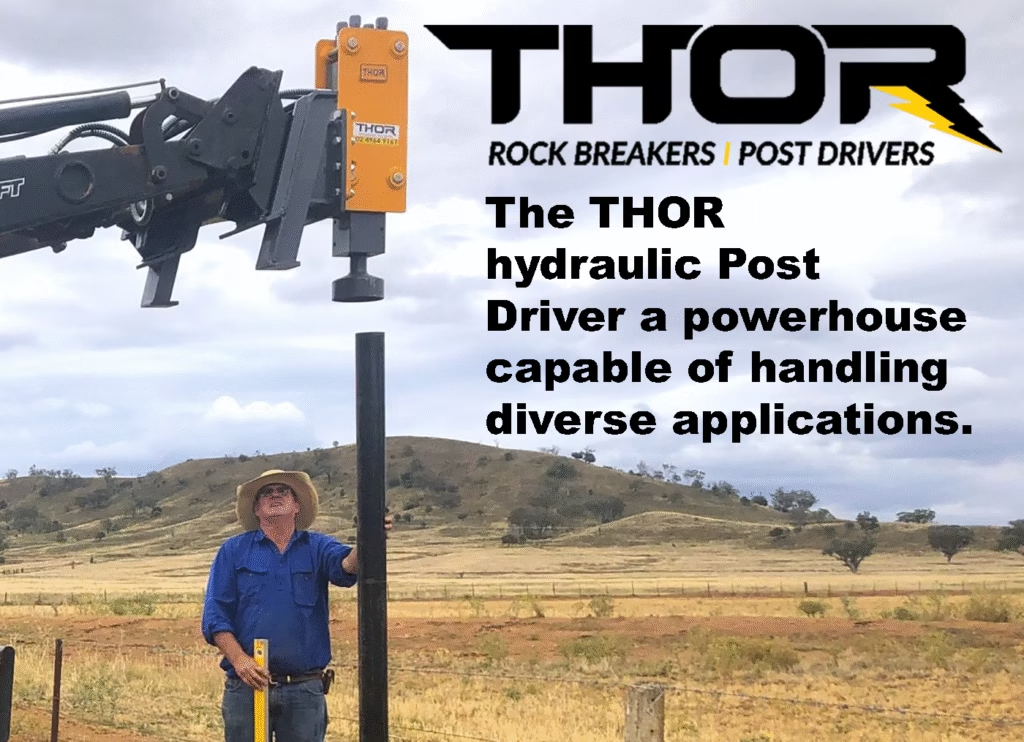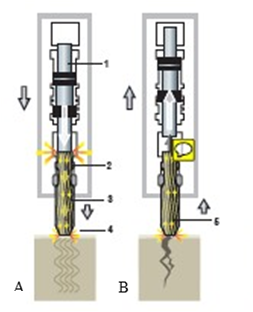
Redefining Performance for Rock Breakers and Post Drivers
Thor employs an advanced piston-driven mechanism, powered by the renowned SB Power Cell that has dominated the industry for over 50 years. Operating at a nitrogen gas pressure of 16.5 bar, this mechanism delivers unparalleled impact Joules.
As hydraulic oil flows from the host machine into Thor’s power cell, it propels the piston within a nitrogen gas chamber. This hydraulic-nitrogen synergy sets the stage for generating substantial impact force. The pressurised hydraulic oil acts as the driving force, propelling the piston downward. This swift motion compresses the nitrogen gas, storing potential energy.
Upon reaching peak pressure, the hydraulic valve opens, triggering a controlled impact as the hydraulic oil is released. This dynamic process harnesses both hydraulic pressure and the stored compressed nitrogen energy. This energy combination propels the piston onto the rock chisel or post tool with formidable blows of impact Joules. Consequently, a sequence of precisely controlled impacts ensues, effectively driving the rock chisel or post tool with optimum force and accuracy. This capability ensures efficient material breakage or installation. The dual-source energy release equips Thor’s rock breakers and post drivers to adeptly adapt to diverse operational demands.
The integration of hydraulic flow control confers a significant advantage. The host machine’s operator can dictate the driver’s speed with precision by regulating the hydraulic flow. By adjusting the hydraulic flow rate, operators can either expedite or moderate the driving action. This adaptability optimally suits various tasks and materials. This level of control empowers operators to tailor the impact intensity to match job-specific requirements, thereby enhancing both operational efficiency and precision.
Minimal Moving Internal Parts – Simplifying Maintenance
THOR’s design philosophy prioritises ease of maintenance. With only two moving internal components – the piston and the valve – maintenance procedures are minimised and streamlined, resulting in reduced downtime and low associated costs. This simplicity extends to disassembly and reassembly, facilitating swift component replacements. This design nuance significantly contributes to prolonged operational uptime, ensuring that maintenance tasks when required are efficient and effective.


Precise Blow Force
Uncompromising Durability
THOR’s commitment to uncompromising durability is exemplified by the use of premium high-strength heat-treated alloy steel in the manufacturing process of our rock breakers. This alloy steel offers an exceptional combination of tensile strength, hardness, and resistance to wear and abrasion. This not only extends the operational life of the equipment but also ensures optimal performance even under the most demanding working conditions. The alloy’s inherent toughness reduces the risk of fractures and deformations, delivering robustness that resonates across diverse applications.
THOR’s commitment to quality is also reflected in our rust resistant nickel plated bolts, flash chromed pins and bosses as well as top quality industrial painted power cells.
THOR’s heavy duty mounts for skid steers, tractors, loaders, and telehandlers weighing 200 – 250kg are made from 16mm and 20mm plate steel and together with their slanted legs and are the most stable on the market. The mounts are quick and easy to attach and when detached from the host machine and when not in use they stand anchored where left, with no danger of them falling over.
The Advantages of Engineering Excellence
THOR’s advance design yields a multitude of advantages. Our focus on robust materials and engineering precision enhances equipment longevity, minimising replacement cycles.
The synergy between hydraulic and nitrogen driven impact results in unparalleled force, enabling efficient material breakage and excavation, the simplicity of our design translates to minimised maintenance demands, ensuring operational continuity.
With THOR rock breakers and post drivers, you benefit from precise, powerful, and reliable equipment that maximises productivity, reduces costs and stands as a testament to innovative engineering excellence.
Elevate your operations today with THOR Rock Breakers and Post Drivers – where advanced design defies a new standard in construction equipment performance.

Post and pile driver attachments convert skid steer loaders into powerful tools for driving fence posts, signposts, guardrails, and foundational piles into the ground. These hydraulic-driven tools increase productivity and reduce manual labor on farms, construction sites, and fencing projects.
2. Types of Post/Pile Drivers
| Type | Description |
|---|---|
| Drop Hammer | Uses a free-falling weighted hammer; ideal for concrete or steel posts. |
| Hydraulic Post Driver | Uses hydraulic power to actuate a piston and drive the post; fast and precise. |
| Vibratory Driver | Uses high-frequency vibration to settle posts—suitable for softer ground. |
| Combo Driver/Puller | Some models can also extract posts using hydraulic pull. |
Hydraulic post drivers are the most common type used with skid steers due to their speed and efficiency.
3. Compatibility & Mounting
3.1 Mounting Interface
- Standard: Universal Skid Steer Quick Attach (SSQA)
- Some models may offer adapter plates for compact track loaders or backhoes
3.2 Size & Weight Considerations
- Verify attachment weight (typically 500–1,200 lbs)
- Ensure it does not exceed the lift capacity of the host skid steer
- Taller driver models require caution in low-clearance environments
4. Hydraulic Requirements
| Attachment Type | Flow Range (GPM) | Pressure Range (PSI) |
|---|---|---|
| Drop Hammer | N/A (gravity-driven) | N/A |
| Hydraulic Post Driver | 8–20 GPM | 2,500–3,500 PSI |
| Vibratory Driver | 10–25 GPM | 2,500–3,000 PSI |
Always check the manufacturer’s spec sheet for minimum GPM and max pressure rating.
5. Key Components
| Component | Function |
|---|---|
| Impact Head / Hammer | Delivers direct force to drive post into the ground |
| Guide Sleeve / Channel | Holds the post vertically for accurate alignment |
| Hydraulic Cylinder or Piston | Powers the hammer stroke (not present in drop hammers) |
| Mounting Frame | Connects the driver securely to the skid steer’s attachment plate |
| Control Valve / Solenoid | Activates impact motion from within the cab |
| Safety Guard / Post Cap | Protects the post head and operator during striking |
6. Operating Procedures
6.1 Setup
- Attach the post driver to the skid steer’s quick attach.
- Connect hydraulic hoses (verify coupler size and cleanliness).
- Test hydraulic engagement to ensure stroke or drop function initiates.
6.2 Driving Technique
- Align the post vertically inside the guide sleeve.
- Lower the driver head to rest on the post.
- Activate the hammer stroke using in-cab controls (joystick or auxiliary button).
- Apply consistent downward pressure as the post enters the ground.
- Monitor depth and plumb alignment throughout the driving process.
- Release and reposition for the next post.
For drop hammers, raise and drop repeatedly until post is driven.
7. Safety Guidelines
- Always wear hard hats, gloves, steel-toe boots, and eye protection
- Ensure no bystanders are within 25 feet during operation
- Do not strike concrete, rebar, or large rocks—may cause ricochet or damage
- Keep skid steer on level terrain to avoid tipping
- Shut down and relieve hydraulic pressure before maintenance
8. Maintenance Schedule
| Task | Frequency |
|---|---|
| Inspect hydraulic lines/fittings | Daily |
| Grease pivot points & bearings | Every 8–10 hours |
| Check piston seals and hoses | Weekly |
| Clean impact head and sleeve | After each use |
| Tighten bolts and frame lugs | Weekly |
| Replace worn post caps | As needed |
Use manufacturer-recommended grease and hydraulic oil. Avoid water ingress into impact components.
9. Common Applications
- Fencing: Agricultural, livestock, or perimeter fencing
- Construction: Guardrails, signage posts, and foundational piles
- Landscaping: Retaining walls, bollards, and vineyard posts
- Municipal Work: Street sign installation, parking barriers
- Oil & Utility: Temporary pipeline markers or pole base driving
10. Selection Tips
 Match GPM/PSI ratings to your skid steer’s hydraulic system
Match GPM/PSI ratings to your skid steer’s hydraulic system Choose drop hammer if simplicity and low maintenance are preferred
Choose drop hammer if simplicity and low maintenance are preferred Select a hydraulic model for high-volume fencing or tough ground
Select a hydraulic model for high-volume fencing or tough ground Look for replaceable post guides and caps to extend service life
Look for replaceable post guides and caps to extend service life Consider tilt or alignment features if working on uneven terrain
Consider tilt or alignment features if working on uneven terrain







